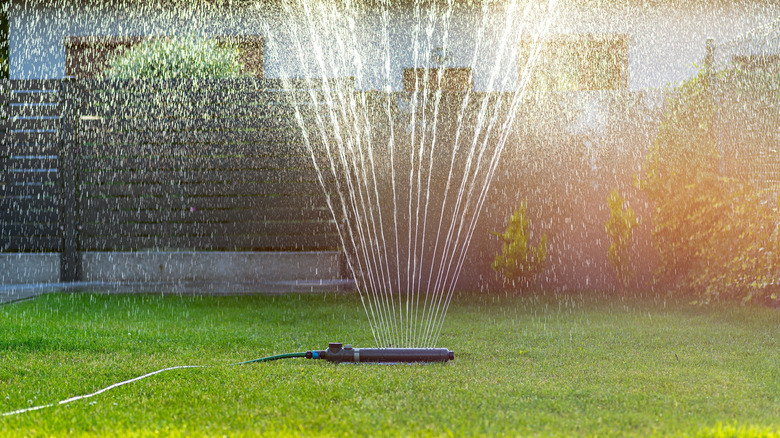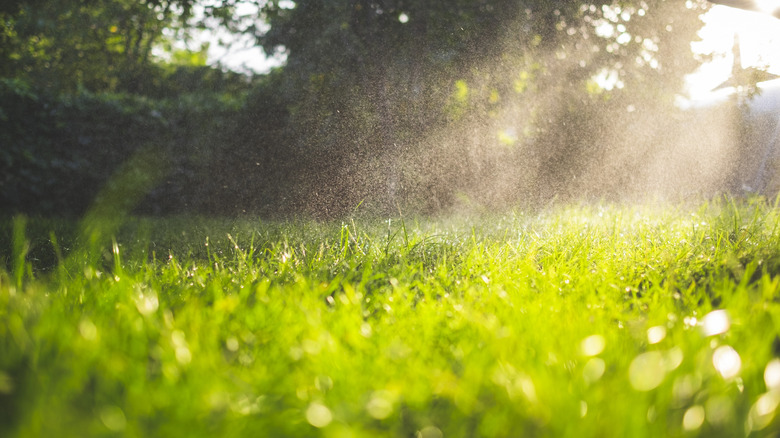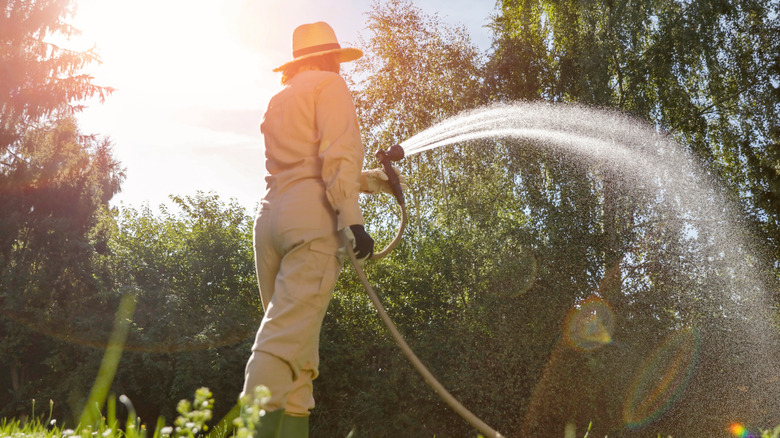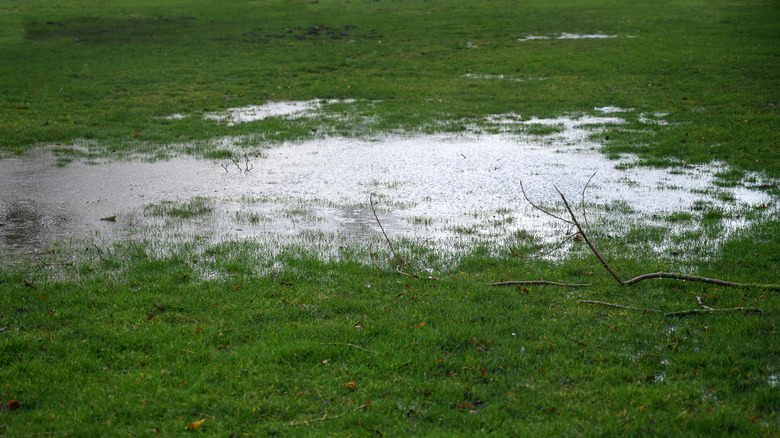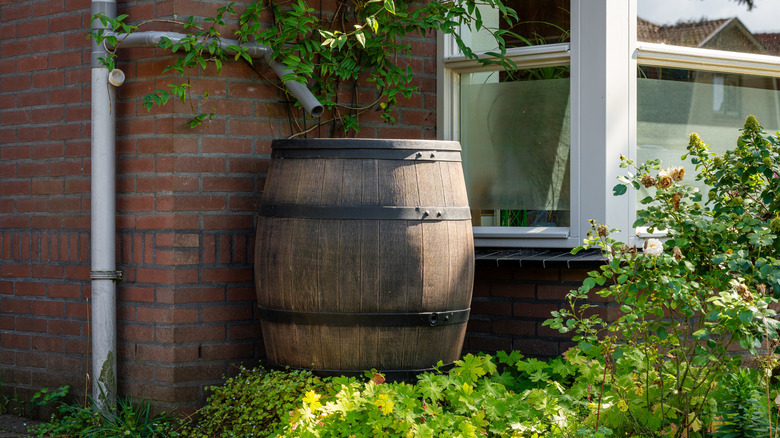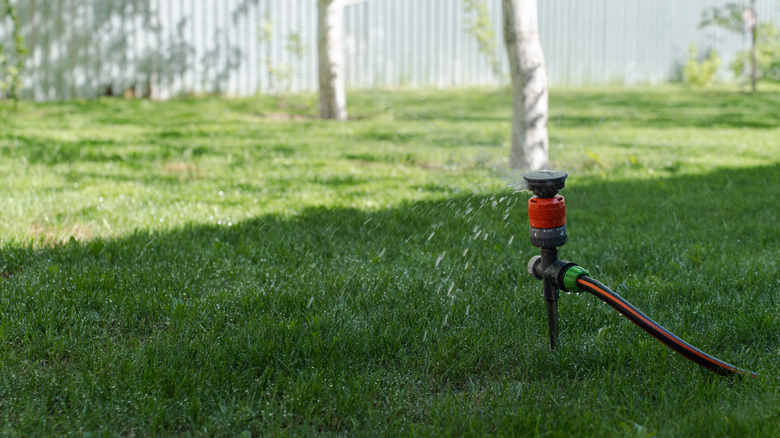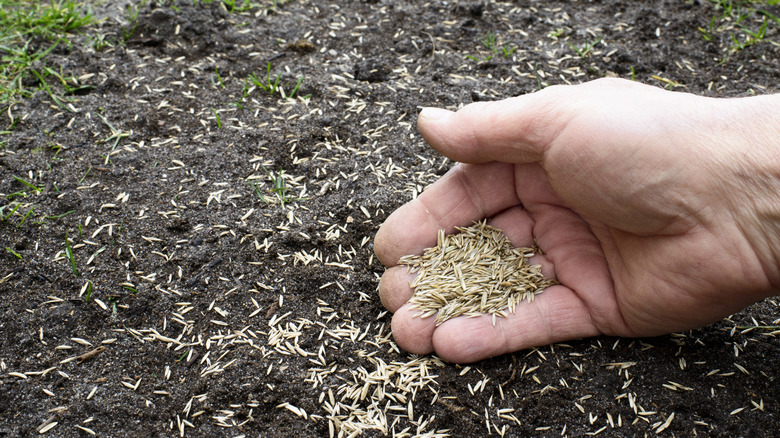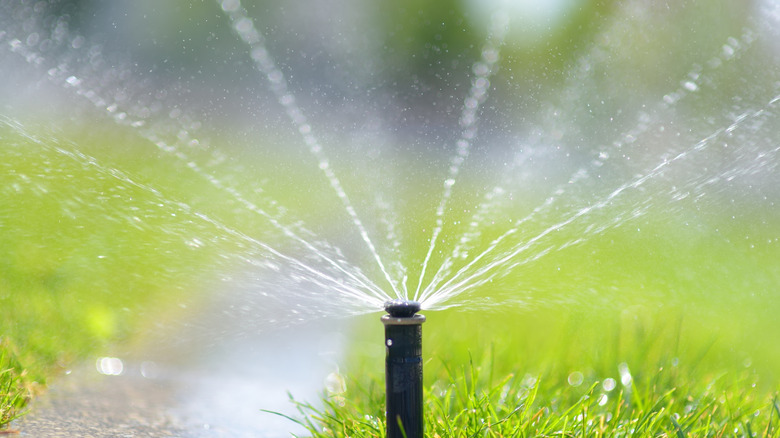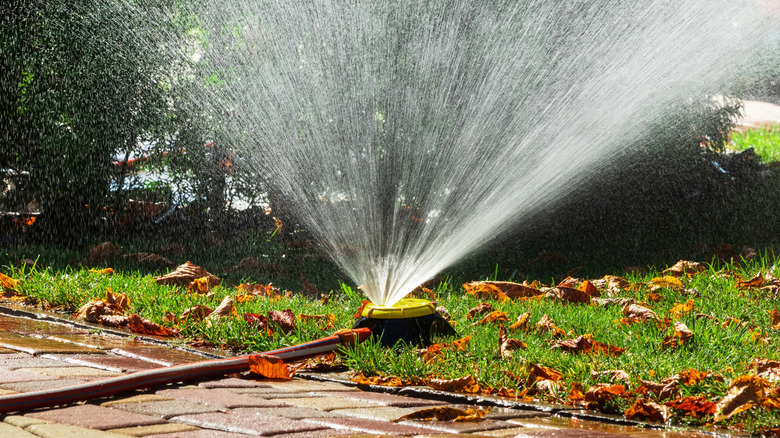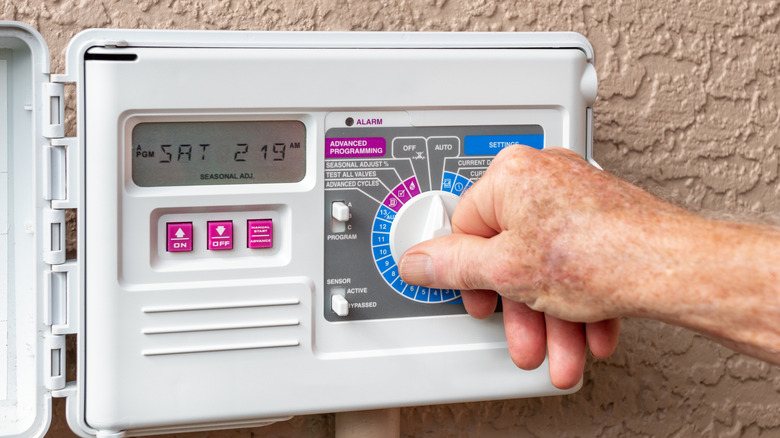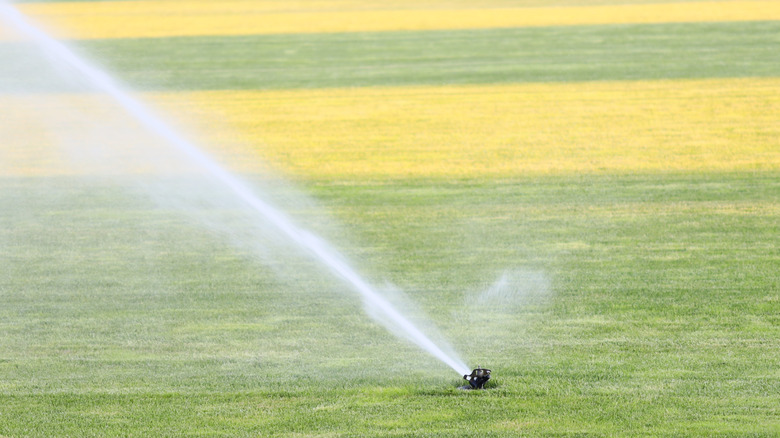Mistakes Everyone Makes When Watering Their Lawn
We may receive a commission on purchases made from links.
Keeping a lawn lush and green requires a lot of hard work and dedication. One essential component of healthy turf is making sure that its needs for water are met. However, while many people understand that grass needs irrigation to grow, they are at a loss for just what they should be doing. Other people think that they know the best way to water their lawns but end up making a mistake that leaves their grass looking unhealthy, causes it to turn yellow, or ends up attracting unwanted pests to the yard.
Clearly, none of these are desirable scenarios. However, watering a lawn is not as straightforward as you may think, and without the proper information and tools, you may just find yourself making a serious mistake. Ahead, we've put together a list of some of the most common errors that people tend to make when watering their lawns. In addition to telling you what you should avoid doing, we'll also help you learn what you should do instead to turn that dream of a lush and green yard into a reality.
Watering during the heat of the day
Did you know that there is a best time of the day to water your lawn? Perhaps, more importantly, did you know that there is a worst time of the day to water it? It's easy to see why you might think that turning the sprinklers on during the heat of the day is a good idea. You could reason that delivering water during this time will prevent the grass from drying out and keep it healthy. However, irrigating at this time is actually a serious mistake that you should be careful to avoid. When you water during the hottest part of the day, a lot of it is going to evaporate before it can seep into the soil and make its way to the grass' roots. Waiting until around sunset is also not a good idea. If the soil doesn't have enough time to absorb the water before the sun goes down, then the moisture will stay on the blades or in the topsoil, running the risk of fungi or diseases becoming a problem.
To avoid these issues, the ideal time to water the lawn is during the early morning hours — before about 10:00 a.m. The temperature will be a bit cooler and wind speeds will generally be lower during this time. If watering first thing in the morning doesn't work for your schedule, you could aim to take care of the grass around 4:00 p.m. This is past the heat of the day, so there should be less concern about the water immediately evaporating. It is also early enough that the soil should be able to absorb most of the moisture to minimize diseases and fungus growth.
Thinking you need to water it every day
Knowing that water is necessary for grass to grow, many people assume that they should be irrigating their lawns every day. They may even conclude that the more water they give their grass, the healthier it will be and the better it will grow. Unfortunately, both of these assumptions are incorrect — and can actually be problematic for your turf. Watering your lawn every day can prevent the blades from developing deep and strong roots. When the moisture they need is always right at the surface, the roots won't penetrate deeper into the soil to search for more.
To avoid this mistake, it is generally only necessary to water turf about once a week. If conditions are very dry, you could consider increasing the frequency to about once every four or five days, but still nowhere near a daily basis. Moreover, if there has been a lot of rain, you can even further space out the schedule as far as once every two weeks. You can quickly gauge whether your lawn needs water based on how the grass responds when you step on it. If it pops right back up, no immediate care is necessary. However, if it stays bent and limp, you'll want to start thinking about watering in the near future.
Not checking how much water your sprinkler system deposits
Every sprinkler is different and won't apply the same amount of water during a set time period. Failing to check just how much water is deposited by your specific system could result in under- or over-watering your grass. Generally speaking, spray heads apply water faster than rotor head sprinklers. However, rates can still vary based on the specific model you have. For example, one spray head may deposit 1 ½ inches of water in an hour, while another could deposit 2 inches in that same time period. Nozzle size can also play a role. As you can probably guess, a larger nozzle will distribute more water than a small head over the same amount of time. With the water pressure consistent at 50 PSI, a 5/32-inch nozzle would spray 5 gallons of water each minute, whereas a 7/32-inch head would spray about 9.5 gallons of water each minute (nearly twice as much). Additionally, factors such as your water pressure and whether you have mixed zone systems (which can lead to uneven watering) will also impact the amount of water.
So, how are you supposed to determine the needs of your lawn? To start, you'll need to assess how much liquid your sprinkler system delivers. Scatter several shallow bowls (empty tuna cans also work well) through the yard, and turn on the system. Turn it off after about 15 minutes and measure how much water is collected in each bowl. From there, you can determine how many minutes you should run your sprinkler in order to provide the ideal amount of moisture for the grass. For example, during the summer, grass should get about an inch of water every week. So, if your cans collected ¼-inch of water in 15 minutes, you'd need to run the sprinkler for one hour (60 minutes) to deliver the recommended inch. Keep in mind that the irrigation needs are lower during the spring and fall.
Overlooking the benefits of rainwater collection
Having access to a hose and sprinklers with running water is definitely a modern convenience. However, that doesn't mean you should solely rely on what flows from the faucet when caring for your lawn. If you overlook the benefits of using rainwater for your grass, you could be adding unnecessary chemicals to your yard while also depriving the grass of beneficial nutrients that could help it grow.
Tap water is often treated with chlorine to disinfect it and ensure there are no harmful germs present. Fluoride is commonly added as well to improve the pH, protect plumbing systems against corrosion, and reduce cavities. While these chemicals play an important role in making tap water safe for us to drink, they are not something that your grass, or specifically the soil, needs. If chlorine levels are too high, for example, it can kill the beneficial microorganisms that live in the soil, which could threaten the overall health of the grass and the other plants in your yard. Rainwater, on the other hand, isn't treated with fluoride or chlorine. But, it is rich in other nutrients that can help keep your grass lush and green, including nitrogen, potassium, phosphorus, and magnesium.
So, instead of always turning on the hose bib when you need to water your grass, consider setting up a rainwater collection barrel — such as the FCMP Outdoor Rain Barrel with Spigots. And because rain is a natural resource, you won't have to spend any money to collect it (beyond the initial investment for a rain barrel), so you can keep your utility costs down (while also minimizing usage and protecting the environment). One quick note: before you set up your rain collection system, check state and local laws. There are a few locations where it is against the law to collect rainwater.
Giving the same amount of water to areas in the shade or sun
When you water your lawn, do you leave the sprinklers running for the same amount of time across the entire yard? If you answered "yes," then you've just identified one mistake you've been making. Watering indiscriminately means that you're not considering the unique needs based on location. You could end up with a waterlogged lawn or end up wasting money and resources.
Grass in the shade needs to be watered differently. Generally speaking, it doesn't need as much irrigation. When you consider that the hot sun causes water to evaporate, it should make sense that areas that are not in full sun will not have as much evaporation. So, overwatering these areas (i.e., giving them the same amount as the rest of the turf) has the potential to leave them sodden. Cut back on how long you leave the sprinklers on in these areas, aiming for less than 1 inch of moisture per week.
Failing to understand that new sod and seeds have different watering needs than established grass
If you've perfected your watering routine for your lawn, you may feel confident in your ability to grow new seed or plant sod. After all, if what you're doing has worked so well on the existing grass, what could go wrong? Unfortunately, this is flawed reasoning that could leave you wondering why your freshly laid grass isn't growing properly. The watering needs of seed and sod are not the same as those for an established lawn.
Let's start by taking a look at sod. It is going to require much more frequent watering than an established lawn — specifically, two to three times a day for the first week, once a day the second week, and then slowly transition to once a week after that. The reason it needs so much more attention is to ensure the roots take hold. Water is key in helping them stretch and search for nutrients, securing the sod in place, and ensuring it gets what it needs to thrive.
So, what about grass seed? It has even more involved watering needs than sod, and definitely will not survive with the weekly schedule that is sufficient for established turf. Instead, you should water new seeds two to four times every day for about 10 minutes during the first two weeks. Once the small blades start poking through (which typically takes two weeks), you can cut back to only giving water once each day for a few weeks and then about once every other day. Only once the seed has taken root and has developed stronger roots can you switch to watering it just once a week with the rest of the lawn (this is typically about six weeks after planting).
Failing to properly position the sprinklers
While using a hose may be more cost effective for a lawn, you're probably better off using a sprinkler system or even individual ones that you can move around. However, if you fail to position the sprinkler(s), then you're gambling with the health of the lawn. It can cause problems ranging from dying grass to wasted water to everything in between. For example, if your sprinklers are placed along the edge of the lawn, then half of the water they spray could end up going into the street or on the sidewalk. On the other hand, sprinklers that are too far apart from one another will leave gaps of grass that don't get sufficient water.
To avoid either of these issues, you need to position the sprinkler to achieve head-to-head coverage. This means that the edge of the water spraying from one of the heads just reaches the next sprinkler. Setting them up this way will help make sure that there are no bare spots on the lawn. You should also verify that the sprinkler heads are facing the right direction to avoid unnecessarily sending water to the sidewalk or street instead of the lawn.
Walking on the grass after watering it
Perhaps you like the feel of wet grass between your toes, or maybe your kids want to play in the backyard a few hours after the sprinklers are turned off. Regardless of the reasoning behind it, walking over wet grass after watering it is a mistake you should try to avoid. The blades aren't the only things that are wet. The soil beneath them is also damp. Walking over it can cause it to compress, removing air pockets and open space. Known as compaction, this can have negative consequences. Grass roots are not able to absorb as much water or oxygen, and the soil itself will be less able to absorb water the next time it rains or you run the sprinklers.
To avoid this, try to stay off of the grass as much as possible after watering it. Wait until the soil has had a chance to dry — your foot shouldn't feel like it is sinking down when you step on it. It is even more crucial to keep any heavy lawn equipment or other vehicles off of the ground while the soil is drying. These machines are much heavier than a person, so they can compress the soil even more tightly, making it harder to revive and really threatening the grass you're trying to keep lush and green.
If you've already made the mistake of walking over wet grass, then you may already have a compaction problem that needs to be remedied. To do so, you'll want to aerate the soil and enhance it using organic matter. Taking these steps should help add those air pockets back in and improve drainage.
Thinking that watering in the fall isn't necessary
Spring is when the grass starts growing again after going dormant in the winter, and summer is when it will need water to survive those sweltering dog days. But, watering in the fall — that's not necessary, right? The temperatures are cooling down and the grass is preparing for the winter, so you can turn off the sprinklers and forget all about them until next spring. Unfortunately, this is simply not correct. If you don't continue watering your grass in the fall, it may not go into winter with the best chances of making it through to the following year. The grass is not yet dormant during the fall, so it still needs consistent watering in order to thrive.
So, to avoid making this mistake when maintaining your yard in the fall, keep that irrigation routine going. You won't need quite as much water during autumn with the lower temperatures, but you should still aim to give your lawn around three-quarters of an inch about once every week. Another reason to continue watering is to support any new grass seed you scattered after aerating and overseeding the lawn. Autumn is the recommended time of year to complete this task, as it is one of the best growing seasons for many types of grass.
Not using technology to your advantage
If you struggle to remember the best time of day to turn your sprinklers on — or even when your lawn is due to be watered again — you might be making the mistake of overlooking how helpful technology could be. Sure, you can physically pull out the sprinkler one morning per week, but if you have lots of tasks to keep up with, this is just over-complicating things for you. Not only is it inconvenient to have to stop what you're doing to turn on or off the sprinklers, but it leaves too much room for error, such as forgetting to turn them off and overwatering the lawn.
Instead, consider investing in an automatic sprinkler system that will let you use technology to your advantage. These will switch on based on a pre-programmed schedule, taking the task off your to-do list. You could even try a weather-based irrigation controller, such as the Orbit B-hyve Smart 6-State WiFi Sprinkler System Controller. These models can modify the set schedule based on the weather. This can reduce water consumption and prevent your grass from getting over- or under-watered.
Even if you don't have a full sprinkler system, there are still ways to use technology to your advantage. You can purchase a timer that connects to your garden hose, automatically turning on and off the water at the set time. Some models, such as the Rainpoint Water Timer, even offer two zones, allowing you to connect them to two hoses and sprinklers to water a larger area at once (and to even customize the timing and duration for different sections).
Forgetting to maintain the sprinkler system
A sprinkler system can be a real asset. However, if you make the mistake of forgetting to maintain it, it won't function properly and may not continue to meet the watering needs of your lawn. For instance, a sprinkler system may start to leak due to corrosion, general wear and tear, or a valve malfunction, and if you aren't routinely checking it, the leak can not only waste water but potentially over-water sections of the yard. But it's not enough just to routinely patrol it — you also need to clean it. For instance, overlooking the recommended frequency for cleaning the lawn sprinkler heads could result in a clog that prevents water from spraying properly.
To stay on top of your system, periodically take the time to check on the sprinkler heads and look for any obstructions that are blocking the nozzle. Clear these away to prevent clogs and ensure the water pressure stays even. You should also assess the operation of the system and look for any leaks, either from the pipes or the heads themselves. Lastly, as your system is running, be sure to assess whether each sprinkler head is angled in the correct direction.
